Nothing can quite compare to the regal standing of a predatory bird. Creatures great and small all stop and stare as the birds of prey open their wingspan and silently glide through the air. Occasionally, the birds will let out a territorial “koaagh koaagh”.
The bateleur eagle is one of these mesmerizing birds. The medium-sized eagle is a colorful species and has earned its title as one of the most majestic African eagles.
They demand adoration simply by being present. But many people don’t know the ins-and-outs of the silent predator.
The bateleur eagle (Terathopius ecaudatus) is a fascinating species, and these 10 facts will help you understand why.
1. An African Eagle Species (With a Bit of an Arabian Presence)
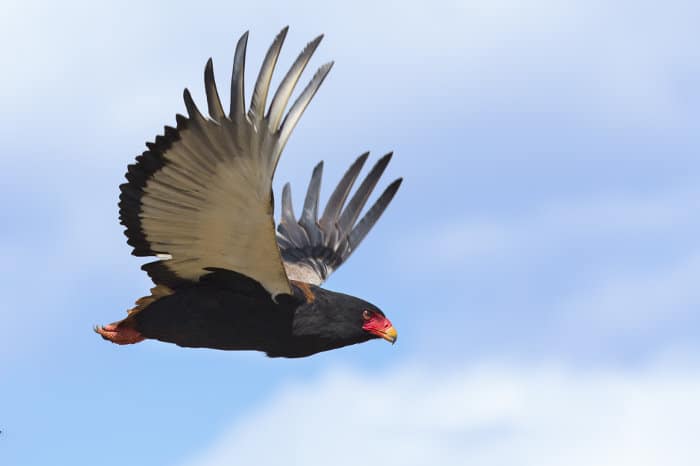
The bateleur is a proudly African eagle. The raptor spends its days soaring through the African sky and scanning for its next meal.
Bateleur eagles are widely distributed in Africa, particularly in the south of the Sahara Desert. But unlike many eagle species, they prefer open land to dense forest.
Are you visiting South Africa? The Kruger National Park, Timbavati Game Reserve, and Sabi Sands are a few places that you might strike lucky with a sighting.
While African grassland and acacia savannah are the habitats of choice, it’s not the only place that you can spot the bateleur.
Bateleur eagles are also endemic to certain parts of south-western Arabia. Particularly areas with similar woodland habitat.
2. Part of the Red and Black Eagle Group
Family history can be a funny thing. And the bateleur has quite an interesting family connection. Belonging to the Accipitridae family, the bateleur’s closest relative is the brown snake eagle.
But despite this connection, the bateleur is the only member of the genus Terathopius.
The bird is easier identified by its appearance rather than its family group. The bateleur’s iconic red face combined with its pitch-black feathers and grey (sometimes tawny) mantle make it quite a sight to behold.
3. “Marvelous Face, No Tail”
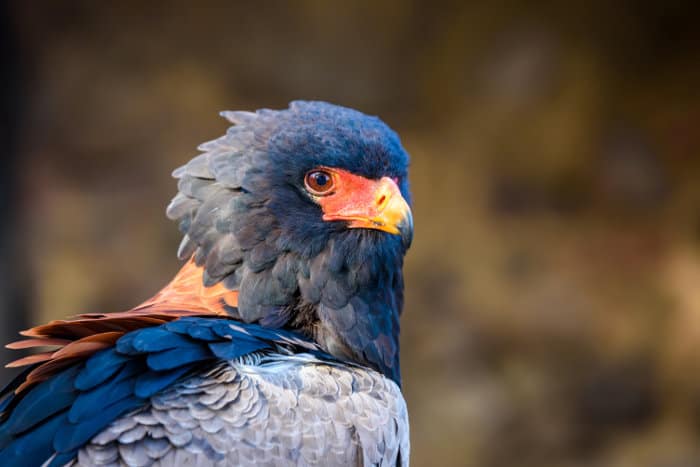
The bateleur is a magnificent sight in flight. You can even catch a glimpse of their white underwing when watching from underneath. But there’s something extra interesting about their form.
When translated from both Latin and Greek, their scientific name means “marvelous face, no tail”. This translation can be a bit misleading as the bateleur does have a tail. But it’s so short that the eagle’s legs extend further than the tail when in flight.
However, chances are that you’ll be more in awe of their striking face than anything else. The bateleur’s red facial skin and beak are characteristic markings and quite beautiful.
4. The National Emblem of Zimbabwe
Have you ever been to the vibrant nation of Zimbabwe? If not, perhaps you’ve seen their flag? The national emblem of Zimbabwe is a stone-carved Zimbabwe bird.
There is no certainty about which bird the emblem displays. However, the general consensus is that it represents the bateleur eagle or the African fish eagle. What an honor!
5. They Spend a Lot of Time Hunting
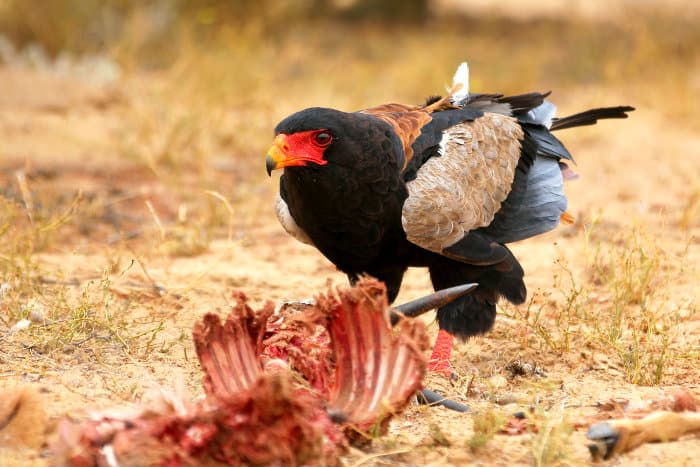
If you think that sitting behind a desk for 9 hours is tough, imagine spending the same amount of time hunting for food!
The bateleur eagle typically spends about 8-9 hours each day on the hunt. As scavenger birds, their menu varies to include a wide variety of prey. You may discover a bateleur snacking on mice and birds one day, and an antelope carcass the next.
6. The Bateleur Eagle Flying Style is Acrobatic
“Bateleur” translates to “street performer”, “juggler” or “circus performer” and the bird lives up to its name. Acrobatic displays and rocking inflight are typical of the bateleur. Their movement is so iconic that there’s even a bateleur eagle dance.
This behavior becomes even more entertaining during the courtship flight. During this routine, they exaggeratedly beat their wings.
The graceful bird is a wonder to watch. Their wings are exceptionally long and their wingspan can grow to be 1,86 meters.
While the top of their wings can be black as the night, their underside is white. This makes for a marvelous sight when viewing them from underneath.
7. Unique Differences Between Male and Female Eagles

Do you want to know how to tell the difference between male and female eagles? Although the same species, the male and female bateleur eagle are different in appearance, also known as sexual dimorphism.
In most species, the males are larger than females. However female bateleur eagles are larger than males. This difference in size is due to the male taking on the role of the sleek hunter. The female’s body supports her role of sitting on the nest for extended periods and appearing large enough to deter predators.
Another key difference is that male bateleur eagles have black feathers on their upper-wing covers and the females’ feathers are primarily brown. This difference in aesthetics is typical of many other species as the male has to win the attention of females for breeding.
8. The Bateleur is a Silent Predator
Bateleur eagles are ominously silent birds. This makes a sighting even more awe-inspiring.
Although mostly silent, there are occasions when the bateleur will make sounds. In certain instances, the bateleur will produce a loud bark as a territorial display.
9. Bateleurs Love the Sun
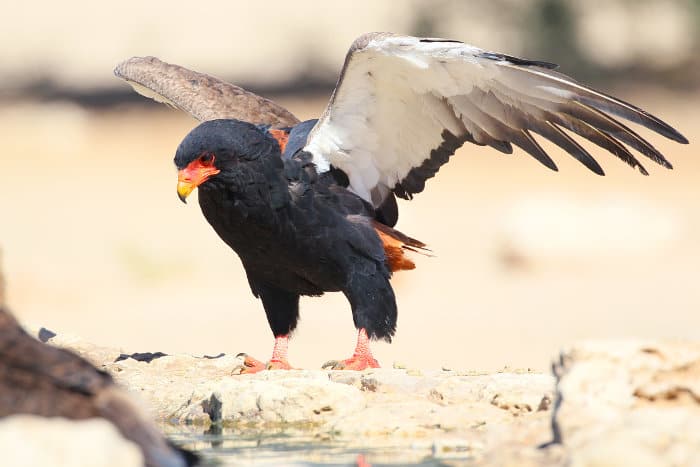
After spending so much time in the air hunting, you’d imagine that the bateleur has very little time for anything else. But that’s not the case.
People will often see bateleurs sunning (or sunbathing). It’s not uncommon for the majestic eagles to dip into various water bodies for a bath. They open their large wings and catch some sun to dry off afterward.
They mostly stand upright and straighten out their wings to catch some rays, but they are also known to lie on the ground with their wings spread out. By exposing their wings to sunlight, the oils in their feathers warm-up and improve its aerodynamics.
10. A Long and Treacherous Journey to Adulthood
The reproduction cycle of the bateleur is long and risky. A male and female will mate for life and will often keep the same nest for several years.
The female will lay a single egg at a time and do her best to protect her eaglet once hatched. A typical growth cycle is as follows:
- The mother incubates the egg for 55-60 days while the father hunts.
- The parents look after the hatching for 110 days before forcing it out of the nest.
- Despite leaving the nest, the eaglet still relies on its parents for food for an additional 3-4 months.
Sadly, only 2% of chicks ever make it to adulthood. But once they do, the life expectancy is an impressive 20-25 years.
11. The Young Body Adapts to Help With Survival
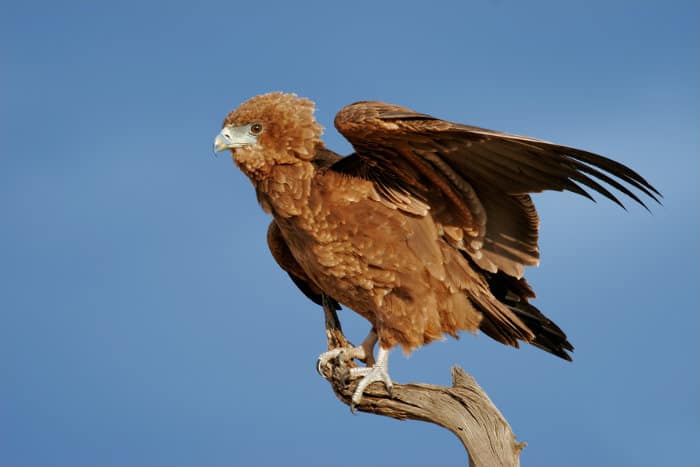
Although adult bateleurs have short tails, this isn’t the case from birth. Juvenile bateleurs have longer tail and wing feathers than their fully grown parents.
This extra length exists to help them learn to fly by giving them additional stability and control. Each year the feathers grow back a little bit shorter after the molting period. Eventually, the juvenile reaches maturity and has the characteristically short tail.
12. The Eagle Changes Color According to Mood
We’ve all seen the cartoons when the character’s face turns red when angry. The behavior of the bateleur eagle is not much different.
Although the bateleur is a typically silent bird, it shows its mood in other ways. The skin of the eagle changes color depending on its mood.
When the bird is calm and relaxed, its skin resembles a pale red which can sometimes appear as orange. This color changes to a bright red on its legs and feet when excited.
The bateleur also shows its mood through other bodily changes. It will spread its mighty wings, raise its crest and puff its chest feathers when agitated. They will also emanate a raspy bark when needed.
The Long and Short of It

While sighting the well-adapted hunters is fairly common in conservation areas, they are more scarce elsewhere. Sadly, various factors put the eagle on the near-threatened IUCN red category list. These factors include the risk of pesticides, the loss of habitat, nest disturbance, and risk of capture for international trade.
The bateleur eagle truly is a remarkable bird, easily identified by their particularly long wings and extra-short tail. Their striking physical appearance and grand demeanor make them one of the most exquisite birds in the world.
If you spot one in the sky or spreading its wings in the sun, then make sure that you take the moment to enjoy this magnificent bird.
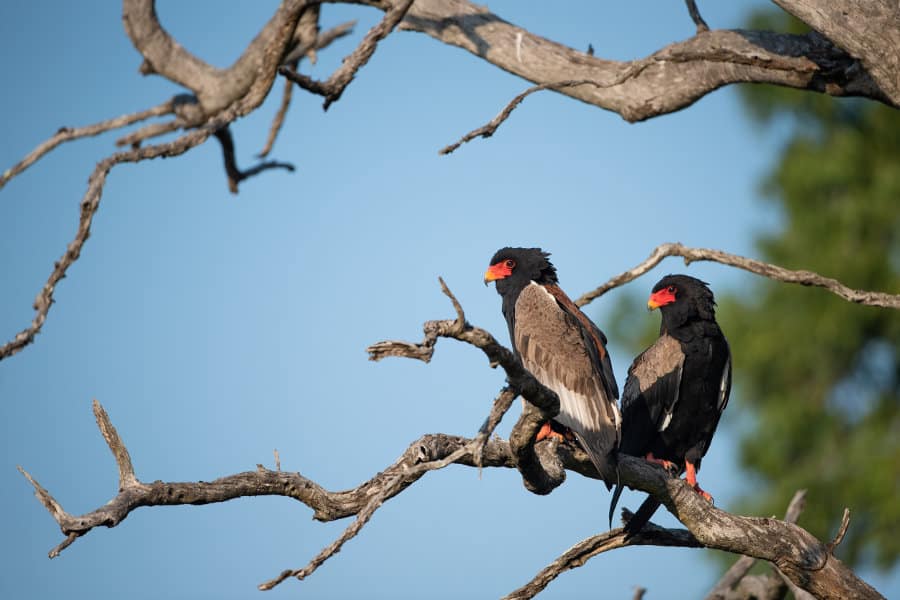


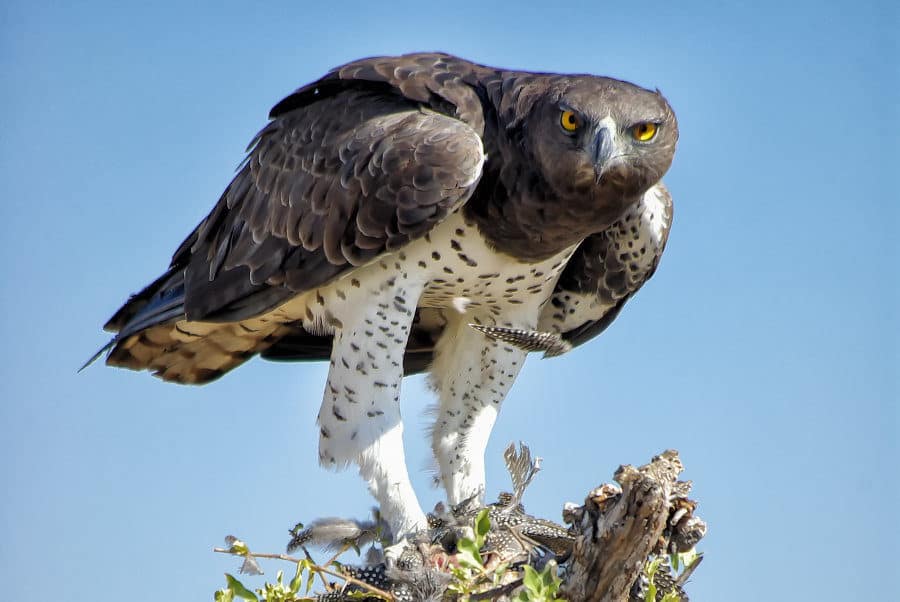
Wow, this was very interesting! I thoroughly enjoyed all the facts. Worthy of sharing.
Deep in southern Zimbabwe, Matabeleland South, Insiza, this bird is famous, the terrain is mountaneous. This awesome eagle was a daily treat in the skies, from the majestic circular glide, to firm flapping that sounded like someone is beating a thudding drum, from courtship dances to rocket dives this eagle was ornamental to see. Would spend up to thirty minutes glazing a flapless glide. Thank you for this post, it now completes my observations.
What a wonderful way to describe this magnificent creature.
Is the Bateleur eagle one of your favorite birds, Brian?
Thanks so much for sharing. 🙂